

Jakobson,
Roman(1896-1982)
Roman Jakobson (1896-1982)
Jakobson, Roman, (1896-1982), Russian-American linguist. Jakobson was professor at the Higher Dramatic School, Moscow (1920-33) and Masarykova University, Brno, Czechoslovakia (1933-39) before moving to the US in 1941. There Jakobson was professor at Columbia Universtity (1943-49), Harvard (1950-67) and M.I.T. (1957-67). A leading authority on Slavic languages, he was the principal founder of Prague school of structural linguistics and of phonology. Author of Remarques sur l' évolution phonologique du russe (1929), Kharakteristichke yevrazi-yskogo yazykovogo soyuza (1931), Kinder-sprache (1941), Aphasie und allgemeine Lautgesetze (1941), Preliminaries to Speech Analysis (with G. Fant and M. Halle, 1952), Fundamentals of Language (1956).
Jakobson announced in 1928 their criticism of the classical structuralist position of Ferdinand de Saussure. Whereas Saussure had insisted that the study of the structural relations within and between languages as they exist at any given time (synchonistic study) and the study of the changes in sounds and their relations over time (diachronic study) were completely separate and mutually exclusive, the Prague School said:
“It is the structural analysis of language in the process of development—the analysis of children’s language and it’s general laws—and of language in the process of disintegration—aphasic language—which enables us to throw light on the selection of phonemes, the distinctive features, and their mutual relations, and to get closer to the main principles of this selection and of this interdependence so as to be in a position to establish and explain the universal laws which underlie the phonological structure of the world's languages”.[Lectures on Sound and Meaning, 1942]
Jakobson also held that Saussure's key insight that sounds had an essentially arbitrary relation to meaning, meaning being determined by their stuctural relations with other sounds which differed in this or that way, was an overstatement.
In 1933, Jakobson became Professor of Russian Philology Masarykova University in Brno, Czechoslovakia, but the impending Nazi invasion forced him to flee Sweden, where he found work as visiting professor. In 1941 he reached the U.S. and taught at Columbia University until 1949 where the Lectures on Sound & Meaning were delivered. From 1949 till 1967, Jakobson held the position of Professor of Slavic languages and Linguistics at Harvard.
相關著作:
1956. Fundamentals of language. Hague: Mouton Press.
1968. Child Language Aphasia and Phonological Universals. Hague: Mouton Press.
1971. Phonological Studies. Mouton de Gruyter
參考資料:
http://www.marxists.org/glossary/people/j/a.htm
http://www.heartfield.demon.co.uk/jakobson.htm
http://www.addall.com/Browse/Author/2081347-1
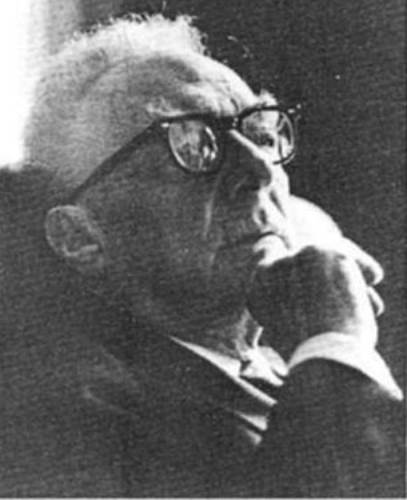
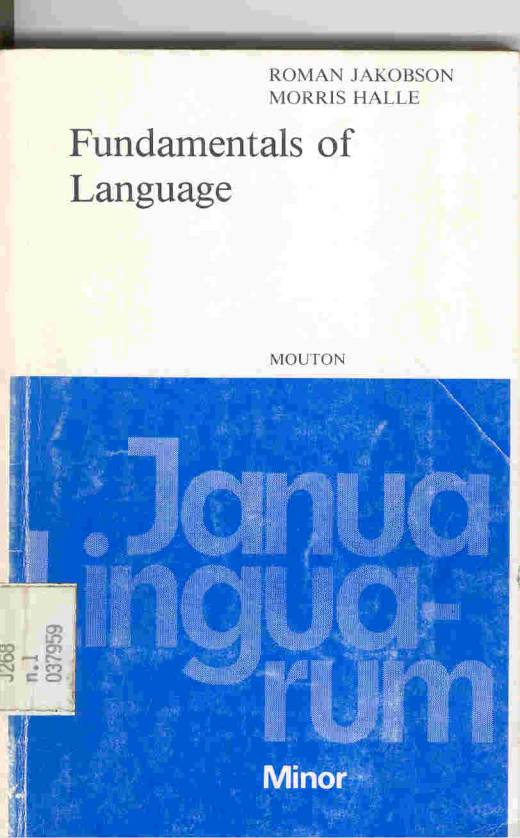
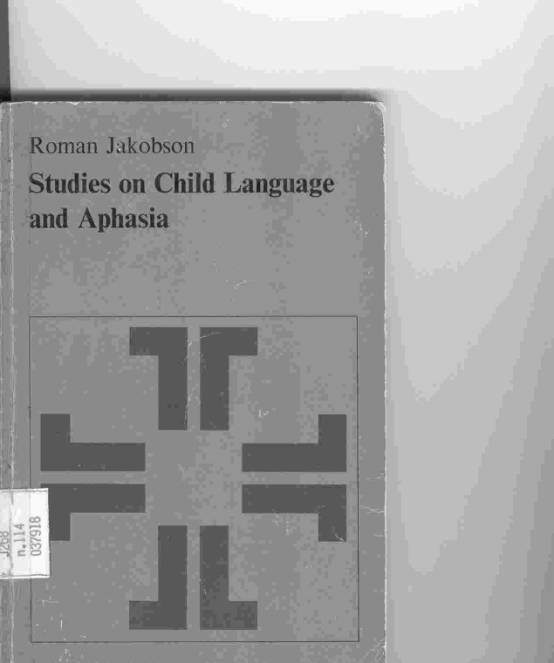
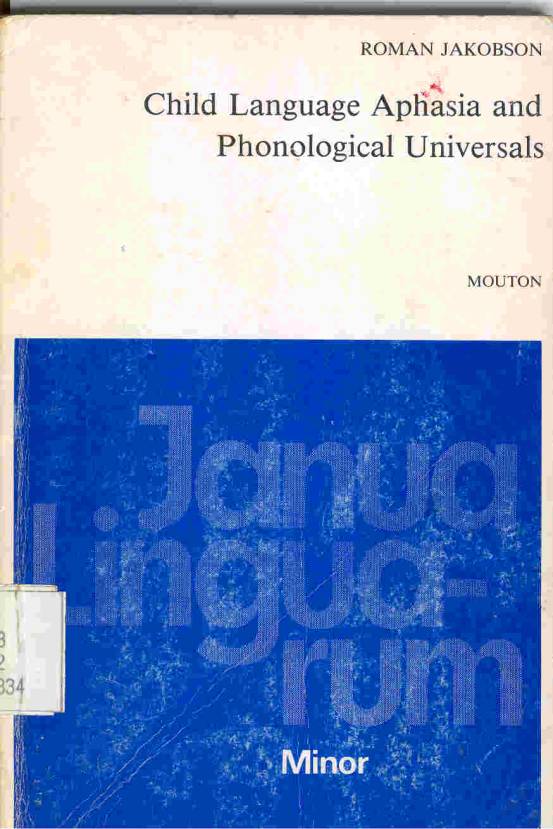
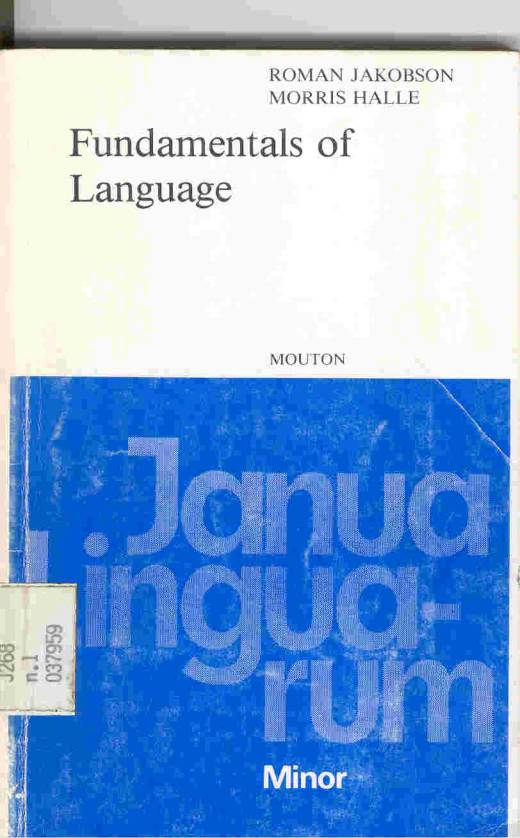
Complete or partial sound-deafness often not only called “sensory aphasia”, but also interpreted as such. Indeed, the nature of the disturbance, as especially Pierre Marie convincingly showed, does not have its roots directly in the concrete acoustic, but rather in the conceptual, “semiotic” sphere( “an intellectual deficiency relating specifically to language”, according to the formulation of this scholar). Not the perception as such, but rather its linguistic value is impaired. A patient who is unable to grasp certain elements of his language, but whose perception of all the remaining auditory sensations is normal ( and, therefore, does not suffer from any auditory agnosia) cannot have any sensory defect. It is customary to compare the agrammatic “telegraphic style” and the similar speech form of children in particular stages of development with imperfectly controlled foreign speech, but the analogy is also valid for phonemic disturbances. In the ordinary comprehension of the phonemes of a foreign language, there are striking correspondences which help to explain linguistically the pathologically facts of sound-deafness. A speaker of Chinese who in listening to a European language does not perceive the difference between r and l, a Scandinavian who often does not distinguish the Russian or German z from s, a Russian or Bulgarian who commonly remains deaf not only to the quantitative but also to the pitch oppositions of the Serbocroatian syllabic phonemes are all thoroughly normal from a sensory point of view and suffer neither from impaired hearing nor from any reduction in the ability to perceive. Since there is no distinctive difference in Chinese between the two liquids, in Russian or Bulgarian between long or short vowels, or vowels with rising and falling pitch, in the Scandinavian languages between voiced and voiceless sibilants, the non-native speaker is therefore not at all accustomed in the language in question to consider these, to him, irrelevant fine points, and his attention and memory must be thoroughly exercised and newly trained so that the otherwise equivalent words of the foreign language can be recognized and will no longer count as homonyms. The aphasic who has forgotten the common distinctive value between r and l or between z and s, or between rising and falling word pitch, takes on the aspect of a foreigner in relation to his native language and therefore can no longer discriminate between such phonological differences.
But what is most difficult for a foreigner is not to grasp but to use, and especially to use correctly, a foreign phonemic distinction which is lacking in his own language. It is not just a question of the difficulty of the unfamiliar articulation. Even if a speaker of Chinese is successful in imitating the r-sound, which is not found in his language, he must still make a special effort to remember that it must actually be used in speech, and to be able to choose correctly between the two liquids in particular cases. Either he does not use the foreign phoneme, or r and l are confused. It is not difficult for a Bulgarian or Pole to lengthen a vowel at will, but it is much more strenuous task for him actually to presever these long vowels when he speaks Serbocroatian or Czech, and, what is more, in the correct places, since a phonemic opposition of long and short vowels does not occur in his native language.
The so-called aphemic disorders ( sound-dumbness or, as it is sometimes called, partial motor aphasia ) and in like manner the beginning stages of child language present a similar picture. Articulation whose autonomous phonemic value has been lost in patients and is not yet incorporated by the child are lacking or are used in place of each other. There are borderline cases: if the second distinction in question or its use in words is indeed known but is felt as foreign or strange, it overstrains the attention; and while it is preserved in special situations, it is avoided in unaffected speech. Many Russians living in Czechoslovakia have learned the quantitative distribution of Czech vowels and can, if necessary, use them accurately, but in fluent speech they easily let this distribution go now and then. “A child”, says Sully, “can often articulate better than he himself wants to”. A one-and-a-half-year-old English girl, e.g., who was teased because she constantly said mudder, laughingly quite accurately pronounced mother, with the interdental fricative, although she afterwards returned to her former pronunciation of this word. There are also less serious cases of sound-dumbness where the patient, under coercion, speaks more correctly for a while, only to slip back again into his usual sound poverty.
This aphasic mutilation of sounds resembles admittedly the so-called arthritic disturbances (i.e., disturbances of the senso-motor apparatus), and this similarity has often misled observers. But as Liepmann (B) has clearly pointed out, a sharp fundamental distinction is necessary here. The lack of both masticating and swallowing disturbances and of other pseudo-bulbar symptoms, as well as very often the undisturbed stste of the expressive elements of speech, proves that in aphemic disturbances “the conceptual design” rather the articulation of speech or the kinaesthetic memory is impaired; or in pther words, the knowledge of particular linguistic operations, rather than the innate instrument which is required for their performance, is lacking.
It has rightly been stressed that not only the mnemic connection of purely kinaesthetic elements, but also the mnemic connection of limb-kinetic complexes with the remaining possession of memory is a prerequisite for the completion of every action. It must be added that as far as the speech sound is concerned there is a mnemic connection not only of the kinetic and superimposed acoustic components, but also, and more important, with that component of the speech sound concerned with content-i.e., the sign-functioning element- to which the first two components are subordinated. Liepmann contrasts sound-deafness ( and receptive aphasia in general) as “an agnosia for conventional signs, for linguistic symbols”, with agnosias in the narrower sense, i.e., “disturbances of sensory impressions which are not symbols”. Accordingly, one can separate sound-dumbness ( and emissive aphasia in general ) as an apraxia for conventional linguistic signs, from true apraxia,i.e., the inability to perform movements associated with objects, rather than symbolic movements. With the failure of the sign-functioning value, the former can sometimes cease, while the latter can sometimes remain preserved.
The production of sounds is a goal-directed activity whose primary purposes lies in the distinctive value of the sound. To the extent that this activity is divested of its purpose, the inability arises, well-known to the pathologists, to accomplish a separate movement.
The autonomy of aphasic disturbances, in contrast to apraxia, finds its explanation in the sign function of speech elements, so that the mutually relative autonomy of aphasic phonemic and meaning disturbances corresponds to the entirely different sign function of the linguistic unit affected. Every morphological unit, from the smallest to the largest-i.e., from the morpheme to the word- has a constant meaning, every phoneme a constant distinctive value. The morphological unit is related, as we have said, to something concrete, and this relation is for one and the same unit a manifold one: In the expressions Bucephalus is a horse, and this cart-horse is a horse, e.g., the concrete relation of the expression a horse, but not its meaning, has changed, as Husserl specifies. The phoneme is related to a morphological entity, and this relation is also, for one and the same phoneme, a manifold one. In the expressions Bucephalus is a horse, and this cart-horse, e.g., the concrete relation of the expression a horse, but not its meaning, has changed, as Husserl specifies. The phoneme is related to a morphological entity, and this relation is also, for one and the same phoneme, a manifold one. Thus the French nasal phoneme a)), e.g., expresses simply that the different different words and types of words in which it occurs( as an, allant, enlever, vente, sang, lent, etc.) contrast in their meaning with words containing a different phoneme in the same position( e.g., sang with saint, son, Ca, sot or lent with lin, long, las, laid,loup). The phoneme, has no direct relation to anything concrete and participates in the distinguishing of meanings without having any meaning itself. The relative frequency of cases of sound-dumbness in relation to the remaining forms of language-dumbness appears to be connected with this poverty of content, which opposes the phoneme to the meaninhful units of language. For the same reason, sentence intonation( and the phonological elements characteristic of the sentence in general) often are preserved in aphasic sound disturbances. In contrast to phoneme, They possess their own constant meaning, as, e.g., the specific intonation at the end of the sentence, which marks the end of a meaningful unit. Oddly enough, the same Pierre Marie who understand clearly the conceptual aspect of the speech sound, or of the loss of speech sounds in his analysis of sound-deafness, failed to appreciate the similar characteristics of sound-dumbness, although it is simply a question of recognizing the emissive counterpart to the corresponding receptive disturbance. Indeed, both types of disturbances, “in their nature and appearance”, are connected very closely with each other. This same scholar even showed himself inclined to group sound-dumbness, not with the other forms of aphasia, in spite of its frequent connection with them, but with the arthritic disturbances, since the essential aphasic characteristic, the damage to “linguistic intelligence” ( or in other words, the impairment of the intellectual functions of speech) is ostensibly absent in sound-dumbness.
According to Niessl von Mayendorf as well, there exists only a gradual distinction between aphasic sound-dumbness and dysarthria. It would be more correct, however, to speak of a gradual distinction between sound-deafness and sound-dumbness and, with Kleist and Fröschels, to consider the former, as opposed to the latter, as a lighter form, or retrogressive stage, of phonemic disturbance and to cite as analogous either the “hearing-dumbness” of the child or the common inability to actively manipulate many foreign linguistic sound distinctions, when there are nevertheless controlled passively. Niessl believes that the boundary between aphasic and arthritic disturbances is “artificially and misleadingly drawn”. An aphasic suffering from sound-dumbness as well as a child learning to talk or an adult attempting to speak a foreign language, speaks of dysarthritically, and consequently suffers from an “ataxia of the speech muscles”. Nevertheless, the loss of babbling sounds by children is not to be explained by a suddenly appearing awkwardness of the speech muscles. Indeed, the nondistinction of rising and falling pitch or of long and short vowels in the Bulgarian pronunciation of Serbian words has nothing whatsoever to do with dysarthria, ataxia of the speech muscles or the infrequent “tongue-lip mechanism”. These same sound features (distinctions of pitch and duration) are used by speakers of Bulgarian, although they have a different linguistic function, that is, they are used as features characteristic of the sentence(sentence intonation, tempo).The fact that, in polyglots suffering from sound-dumbness, one language can be affected while another remains undamaged proves that they cannot be suffering from an “ataxia of the speech muscles”. And from the frequent cases of single sound paraphasia”, which one could interpret as an incomplete or partially restored sound aphasia, it follows that phonemic distinctions can be lost without the loss of any articulation. Thus there are,e.g., patients who produce both liquids, but nevertheless indiscriminately replace r with l and conversely l with r .
Toward A Linguistic Typology of Aphasic Impairments
In
the speech of speech pathology, one approach at variance with linguistic reality
is the hypothesis that language impairments in aphasia can be viewed as unitary
general disorder, with the allegedly dissimilar types of aphasia representing
differences in quantity of disturbance, rather than in quality. Any linguist who
has had the opportunity to observe different specimens of aphasic speech can
only confirm and support the views of those neurologists, psychiatrists and
psychologists who are getting an increasingly clearer insight into the
qualitative diversity of the aphasic patterns. A linguistic analysis of these
patterns imperatively leads to the ascertainment of distinct and integral
syndromes as well as to their structural typology. The linguistic errors made by
the adherents of the unitarian heresy have prevented them from discriminating
between the various verbal failures of aphasiacs.
If aphasia is a language disturbance, as the term itself suggests, then any description and classification of aphasic syndromes must begin with the question of what aspects of language are impaired in the various species of such a disorder. This problem, which was approached long ago by Hughlings Jackson, cannot be solved without the participation of professional linguists familiar with the patterning and functioning of language.
To study adequately any breakdown in communications we must first understand the nature and structure of the particular mode of communication that has ceased to function. Linguistics is concerned with language in all its aspects- language in operation, language in shift, language in the nascent state, and language in dissolution.
At present there are psychopathologists who assign a high importance to the linguistic problems involved in the study of language disturbances; some of these questions have touched upon in the best recent treatises on aphasia. Yet, in most cases, this valid insistence on the linguist’s contribution to the investigation of aphasia is still ignored. For instance, a new book, dealing to a great extent with the complex and intricate problems of infantile aphasia, calls for a coordination of various disciplines and appeals for cooperation to otolaryngologists, pediatrician, audiologists, psychiatrists, and educators; but the science of language is passed over in silence, as if disorders in speech perception had nothing whatever to do with language. This omission is the more deplorable since the author is Director of the Child Hearing and Aphasia Clinics at Northwestern University, which counts among its linguists Werner F. Leopold, by far the best American expert on child language.
Linguists are also responsible for the delay in undertaking a joint inquiry into aphasia. Nothing comparable to the minute linguistic observations of infants of various countries has been performed with respect to aphasics. Nor has there been any attempt to reinterpret and systematize from the joint of view of linguistics the multifarious clinical data on diverse types of aphasia. That this should be true is all the more surprising in view of the fact that the amazing progress of structural linguistics has endowed the investigator with efficient tools and methods for the study of verbal regression and the aphasic disintegration of the verbal pattern may provide the linguist with new insights into the general laws of language.
The application of purely linguistic criteria to the interpretation and classification of aphasic facts can substantially contribute to the science of language and language disturbances, provided that linguists remain as careful and cautious when dealing with psychological and neurological data as they have been in their traditional field. First of all, they should be familiar with the technical terms and devices of the medical disciplines dealing with aphasia; then, they must submit the clinical case reports to through linguistic analysis; and they should work with aphasic patients in order to approach the cases directly and not only through a reinterpretation of prepared records which have been quite differently conceived and elaborated.
There is one level of aphasic phenomena where amazing agreement has been achieved during the last twenty years between those psychiatrists and linguists who have tackled these problems, namely the disintegration of the sound pattern. This dissolution exhibits a time order of great regularity. Aphasic regression has proved to be a mirror of the child child’s acquisition of speech sounds: it shows the child’s development in reverse. Furthermore, comparison of child language and aphasia enables us to establish several laws of implication. The search for this order of acquisitions and losses and for the general laws of implication cannot be confined to the phonemic pattern but must be extended also the grammatical system. Only a few preliminary attempts have been made in this direction, and these efforts desever to be continued.
References:
1956. Fundamentals of language. Hague: Mouton Press.
1968 .Child Language Aphasia and Phonological Universals. Hague: Mouton Press.
1971. Studies on Child Language and Aphasia. Hague: Mouton Press.